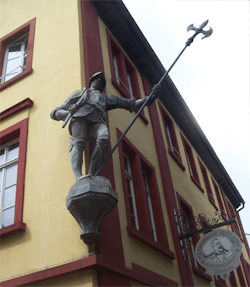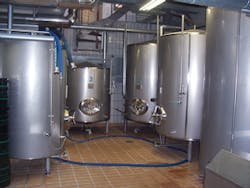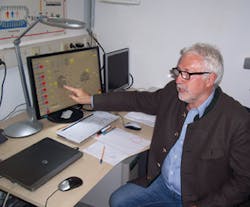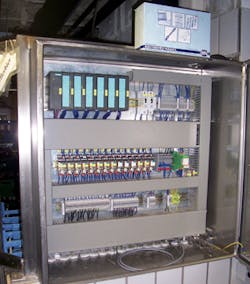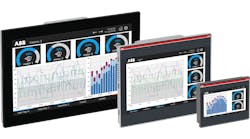There are a lot of breweries in Germany, but there used to be many more. This is because good beer is delicate and historically difficult to transport—subject to taste-degrading temperature changes, fermentation problems and container explosions. That's why many small towns and neighborhoods in Germany's larger cities used to have their own breweries, and why better handling and logistics—as well as pasteurization and filtering—eventually led many to close.
Jurgen Marz, president of Heidelberg Kulturbraurei AG brewery, pub, living museum and hotel, reports his mid-sized university town used to have 45 breweries. The first official citation of the former "wirtschaftshof" or farmyard on the Kulturbraurei's site dates back to 1235, when it supplied the city's famous Heidelberg Castle. In the 18th and 19th centuries, several generations of the Schaaf family brewed beer for the location's Zum Seppl tavern and several other pubs in the city (Figure 1). However, it eventually fell into disuse, and the municipality bought it.
Preserving tradition
Figure 1: A knight stands guard above the entrance to Heidelberg Kulturbraurei brewery, pub and hotel, where beer was first made in the 18th and 19th centuries by several generations of the Schaaf family for local taverns, and began to be brewed again in 2000 by the Marz family's cultural organization.
Photo credit: by Jim Montague
Marz's family purchased the facility in 1996, rebuilt it and established Kulturbrauerei Heidelberg as a cultural preservation organization, and started present operations in 2000.
Though the brewery and its owners, operators and community achieved a happy ending, there were some obstacles along the way. One of the most challenging arose because Heidelberg Kulturbraurei's mission is to preserve and carry on the region's brewing methods and traditions. This means adhering to Germany's 500-year-old Reinheitsgebot tax law, requiring that beer be made only from water, barley, hops and yeast. It also means not filtering or pasteurizing its beer, heating to 70 °C during production, avoiding oxygenation or uncontrollable outside yeast that could harm the beer's taste, and following other traditional requirements.
Also read: Process safety would be better if it had strong regulations as German beers do
Monitoring and properly adjusting all these conditions takes lots of time and manpower. This wasn't a problem in past decades and centuries when manual labor was plentiful and cheap. But, in the 21st century, labor is costly and often scarce. Though much closer to a microbrewery than an industrial-scale operation, Marz reports that Heidelberg Kulturbraurei had to adopt some form of process automation.
Figure 2: Only water, barley, hops and yeast go into the fermenting and storage tanks at Heidelberg Kulturbraurei, which employ actuated and automatic valves, air separators, heat exhangers, PLC, HMI software, Profibus networking and Rittal enclosures to make three main varieties of kraüsen, mibock and bock beers from classic recipes.
Photo credit: by Jim Montague
"Heidelberg Kulturbraurei tries to duplicate the conditions of 1900 and before, but now we have to try to do it with modern technology," explains Marz.
The brewery's basic process begins by turning barley into malt by mixing barleycorn with water, germinating it, and then roasting it—lightly for light beers, and darker for dark beers. Hops flowers from Munich, Australia and the United States are added later to give the beers their bitter and refreshing flavors, while yeast promotes fermentation of the mash's sugars into alcohol. Heidelberg Kulturbraurei produces three main varieties of kraüsen, mibock and bock beers from classic recipes.
Besides its half-dozen fermenting and storage tanks, the brewery's equipment includes Burkert activated valves, Baelz modulating valves, a Klockner ASM 220 air separator, and an Alfa Laval heat exchanger to remove heat from the tanks and pre-cool the mash on its way to the tanks (Figure 2).
Figure 3: Jurgen Marz, president of Heidelberg Kulturbraurei, demonstrates the on-screen layouts and Siemens Win CC HMI software that he and his colleagues use to monitor and maintain the brewery's process applications, which strive to replicate and automate the region's old-time brewing methods and results.
Photo credit: by Jim Montague
"We cold ferment at 5-6 °C, which means the yeast makes less alcohol," adds Marz. "In addition, after seven to 10 days, we interrupt the fermentation process, store the beer at -1 °C for six weeks, take the old yeast mixture out of the tank's bottom, and add new yeast from a yeast bank near Munich. We use the best ingredients we can, but we also leave the beer alone for much longer than industrial producers. We strictly follow these steps, which means low fermentation, no oxygen, and everything for each batch made in one tank. The four primary areas we need to control are mash, fermentation, temperature and storage."
Old problems, modern fixes
Just two years ago, Marz added that Heidelberg Kulturbraurei brought in software integrator Albert Frey to help further upgrade its recipe, monitoring and control systems. "This latest upgrade was needed because, over the past 15 years, we probably came up with 50 different beers, and the recipes and specifications for all of them have to be stored and retrieved as needed. We eventually adopted WinCC HMI software from Siemens, and Albert developed the display and interfaces for us." (Figure 3)
Figure 4: Heidelberg Kulturbraurei's brewing operations, including temperature loops, pressure and other variables, are controlled by 24 direct inputs and eight direct outputs, which are managed by a Siemens S7 300 PLC and support components in a Rittal 1014 stainless-steel, wall-mount cabinet.
Photo credit: by Jim Montague
To design and implement the brewery's new control system, Heidelberg Kulturbraurei also sought help from a local system integrator, Wolf GmbH, which helped it implement a Siemens S7 300 PLC to manage 24 direct inputs and eight direct outputs from the tanks' temperature control loops and pressure devices. All these control devices, power modules and other components are networked via Profibus protocol, and housed in a Rittal 1014 stainless-steel, wall-mount cabinet (Figure 4).
Marz adds that Heidelberg Kulturbraurei's new HMI software and its PLC-based controls enable the brewery to quickly identify and respond to operational issues as they arise, which helps it maintain the authenticity and quality of its many beers. "Just like in any other process, sometimes temperature control problems come up. However, in our situation brewing beer, even a 5 °C difference can make a difference in the condition of the mash. We can have different enzyme levels requiring different behaviors at every step of our process. As a result, it really helps that our PLC and HMI software can let us know when and where a fault has happened because we can quickly replace a sensor or do whatever needs to be done to keep up and running smoothly."

